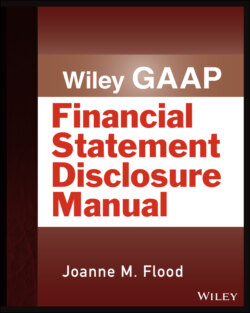Читать книгу Wiley GAAP: Financial Statement Disclosure Manual - Joanne M. Flood - Страница 16
DISCLOSURES AND PRESENTATION REQUIREMENTS ASC 205‐10, Overall
ОглавлениеComparative Statements To increase the usefulness of financial statements, many entities include financial statements for one or more prior years in their annual reports. Some also include five‐ or ten‐year summaries of condensed financial information. While not required, ASC 205‐10‐45‐1 emphasizes that the presentation of comparative financial statements in annual reports enhances the usefulness of such reports and brings out more clearly the nature and trends of current changes affecting the enterprise. Comparative presentations demonstrate the fact that the statements for a series of periods are far more significant than those for a single period and that the accounts for one period are but an installment of what is essentially a continuous history.
Full Set of Financial Statements A full set of financial statements consists of:
1 Financial position at the end of the period.
2 Earnings (net income), which may be shown in a separate statement or within one continuous statement of comprehensive income.
3 Comprehensive income for the period in one statement or two consecutive statements.
4 Cash flows during the period.
5 Investments by and distributions to the owners during the period.(ASC 205‐10‐45‐1A)
Order of Data The order of data is not prescribed. However, for tabular information, it is good practice to present information by year with the most current year appearing consistently in either the first or last column.
Changes Affecting Comparability Comparative information should be consistent. Any exceptions to comparability must be disclosed as a reclassification, and accounting change, or correction of an error, as described in ASC 250. (ASC 205‐10‐45‐3) To the extent they remain significant, notes to financial statements should be repeated in comparative statements or at least referred to. (ASC 205‐10‐45‐4 and 50‐2)
Presentation Here are the presentation items required for GAAP:
Include name of entity for which statements are being presented (if d/b/a is different name from legal name, indicate both).
Titles of statements should be appropriate (certain titles denote and should be reserved for GAAP financial statements; other titles denote other comprehensive basis of accounting [OCBOA] financial statements).
Dates and periods covered should be clearly stated.
If comparative statements are presented, repeat or at least refer to notes from prior years to the extent they continue to be significant. (FASB ASC 205‐10‐45‐4 and 50‐2)
Differences between “economic” entity and legal entity being presented should be noted (e.g., consolidated or not, subsidiaries included and excluded, combined statements, etc.). Disclose summarized financial information for previously unconsolidated subsidiaries.
Disclosure There is only one required disclosure for this subsection listed in the Codification:
For reclassifications or other reasons, if changes have occurred in the manner or basis of presenting corresponding items in two or more periods, disclose the explanation of the change. (FASB ASC 205‐10‐50‐1)
